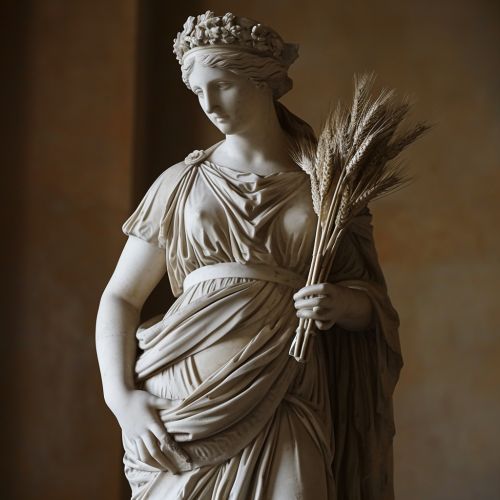Demeter
Overview
Demeter is a prominent figure in Greek mythology, known as the goddess of harvest and agriculture. She is credited with the gift of agriculture to mankind, teaching them how to sow and cultivate crops. Demeter is also associated with the cycle of life and death, symbolizing the changing seasons and the balance of the natural world.


Origins
Demeter is the daughter of the Titans Cronus and Rhea. She is one of the twelve Olympian gods who resided on Mount Olympus. Her siblings include Zeus, Hades, Poseidon, Hera, and Hestia. The name 'Demeter' is believed to be derived from the Ancient Greek words 'de' and 'meter', meaning 'earth mother'.
Role and Responsibilities
As the goddess of harvest and agriculture, Demeter was responsible for the fertility of the earth. She was revered for her control over the growth of crops and was often invoked for successful harvests. Demeter was also associated with the sanctity of marriage, the sacred law, and the cycle of life and death.
Iconography
In ancient Greek art, Demeter is often depicted as a mature woman, wearing a crown and holding a torch, a sheaf of wheat, or a poppy flower. These symbols represent her dominion over agriculture and her connection to the earth.
The Eleusinian Mysteries
Demeter is central to the Eleusinian Mysteries, ancient religious rites held annually in the city of Eleusis. The mysteries revolved around the myth of the abduction of her daughter, Persephone, by Hades, the god of the underworld. The rituals symbolized the agricultural cycle of planting and harvesting, and the eternal cycle of life and death.
Influence on Roman Mythology
In Roman mythology, Demeter was identified with the goddess Ceres, who was also a deity of agriculture and fertility. The Roman version of Demeter incorporated many of the Greek goddess's attributes and myths, including her role in the Eleusinian Mysteries.
Legacy
Demeter's influence extends beyond ancient mythology. Her association with the life-giving aspects of the earth has made her a figure of reverence in neopagan and Wiccan traditions. The myth of Demeter and Persephone has been interpreted in modern times as a reflection of the cycles of nature and the changing seasons.
